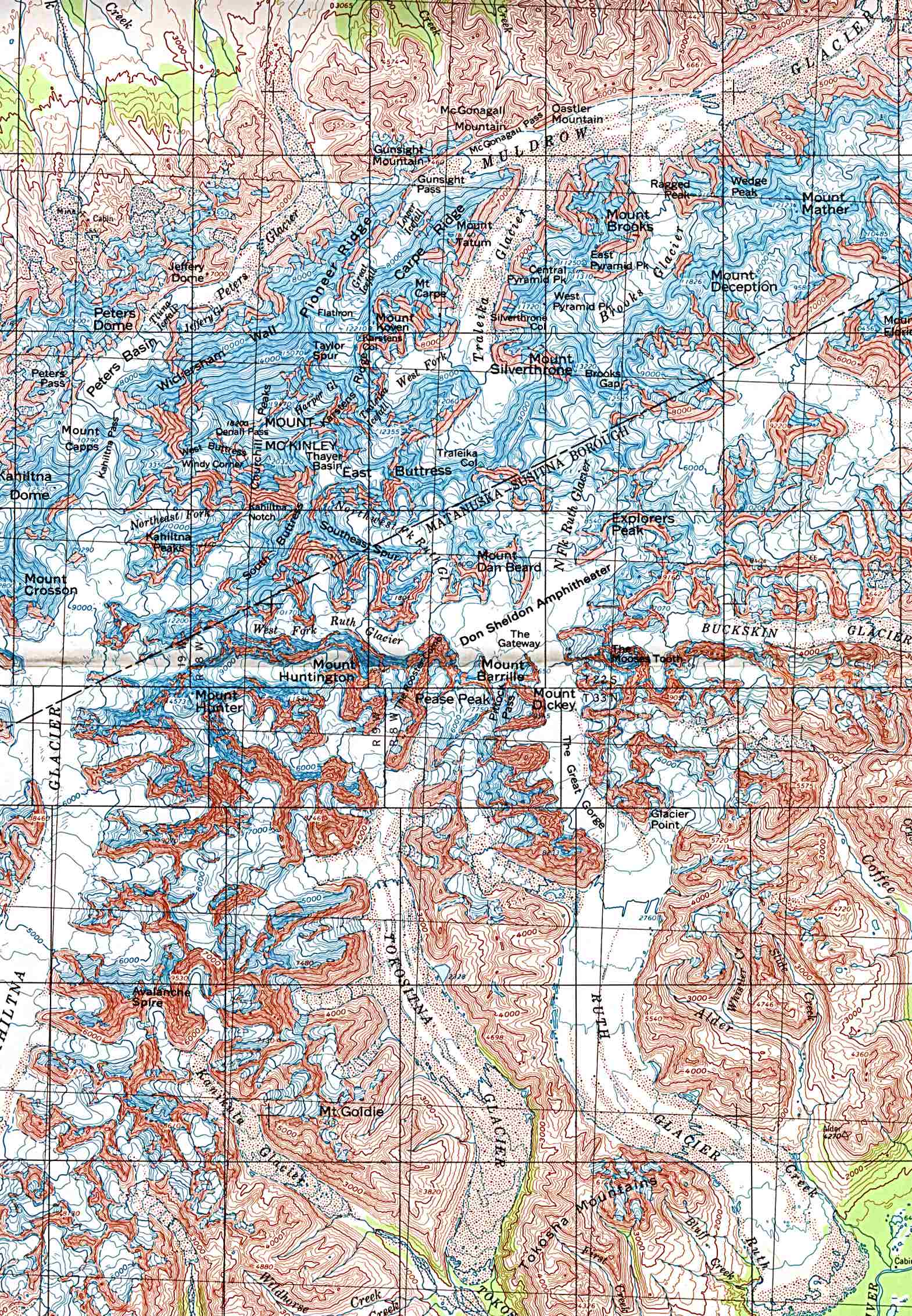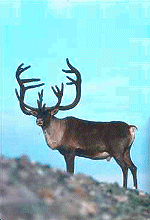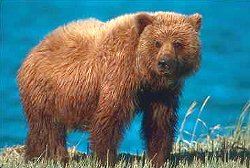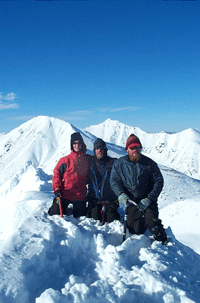Voyage
to
Mars
A Sample
The Process
Extreme Travel Adventure Challenge







A Sample
Extreme Adventure Challenge Report
Denali (Mount McKinley), Denali National Park, Alaska, USA
~ prepared by Kelly, Mufassa, and Zoe ~
The Challenge
|
Our task is to travel by foot
from a point on the Alaska coastline at the Pacific Ocean to the
peak of Denali (meaning “The
Great One”) in the state of Alaska. Denali (formerly Mount
McKinley) is the highest mountain in North America, at 20,300 feet
(7,380 meters). To a human standing at the base, it is the tallest
appearing mountain, even taller than Mt. Everest. |
Geographical Study
|
The track begins on the rocky shore of the Pacific
Ocean near the city of Anchorage, Alaska (61.218 degrees N, 149.9
degrees W). We must travel a straight-line
distance of 132.9 miles (213.9 kilometers) to the peak of Denali
(63.069 degrees N, 151.004 degrees W). The actual path of the mission
will undoubtedly carry us much beyond a total distance of
132.9
miles depending
upon the path chosen. Along the way we will pass through a broad
coastal plain that is today mostly town and farming communities crisscrossed
by many roads. As we move inland, however, we will find rugged
wilderness, and then a series of foothills, and finally the mountains
of the Denali Range.
The landscape is filled with many rivers, creeks, and ravines, but
very few roads. As we move toward Denali, we must pass through Denali
National Park. Over the entire path we are more or less constantly
going up; we start at sea level and rise to an altitude of 600 meters
(1,850 feet) at the base of the mountain. Across much of the valley
leading up to Denali we will come across old-growth forests composed
of pine and fir trees. It is expected that the group will move at
a rate of about 10 miles per day on average until we have to climb
the mountain. Then, our rate will be much slower. Given the approximately
120 mile path, this will take about 12 days
to
travel
the distance
to the mountain, but at least 14 days will be required to climb to
the top of Denali. |
Weather Study
|
Summers at Denali National Park are often cool and
damp. Layers of clothing, including
good rain gear and hiking boots will be required for our summer trip.
Traveling at any other time will bring much colder temperatures and
very short daylight hours. The average high temperature during July,
the hottest month of the year,
is 66
degrees F by day at the base of Denali; 43 degrees F is the average
by night. Temperature on the mountain will become lower as we climb
higher. Climbing Denali might result in the team members encountering
extreme weather. Even during the hottest days of the summer (July)
the mountain
remains icy cold and snow capped. Its top is mostly wrapped in clouds
during this time. At almost any time of year the summit is swept
by strong winds often
carrying
snow.
The higher we climb, the less oxygen there will be for us to breathe.
Anoxia, sometimes called altitude sickness, occurs when there is
an absence
of oxygen
supply
to an
organ's tissues. When we climb the mountain, we will have to carry
an oxygen supply with us. |
Plant & Animal Study
|
Denali Park and the surrounding areas are filled with a wide variety of animal and plant life. The larger animals we are likely to encounter on this Extreme Travel Adventure are the following: mountain sheep, caribou, moose, wolves, grizzly and black bears. Smaller mammals include fox, weasel, wolverine, lynx, marten, snowshoe hare, hoary marmot, red squirrel, ground squirrel, pika, porcupine, beaver, shrew, vole, and the lemming. There are 37 mammal species recorded in the Denali park and preserve. Bird life is quite varied, and include the following: wheatears, ptarmigan, longspurs, short-eared owls, and northern harriers. Golden eagles and other raptors such as the hawk owl and goshawk might be encountered. One might also spot plovers, gyrfalcons, mew gulls, and snow buntings among the 156 species of birds recorded at Denali. Raven, ptarmigan, magpie, and gray jay are some of the species that winter in the area. |
Risk Management
|
Four risks are involved in this Extreme Travel Adventure mission: (1) bears, (2) falling, (3) extreme weather, and (4) anoxia. Denali National Park is home to black bears and grizzly bears. Black bears live in forested areas and are rarely seen by visitors. Grizzly bears live mainly on the open fields and valleys, and are often seen by visitors along the park roads. If annoyed, these animals can become very dangerous. They have been known to kill people. Bears are active both day and night and can be found anywhere. The team must be alert and careful at all times, and in all places. The team will avoid surprising bears, and will never intentionally approach a bear. Falling, extreme weather, and anoxia are all likely to be encountered while climbing Denali. The risks of climbing a 20,000-foot mountain are mostly obvious. Falling can be avoided by using standard mountain climbing routines such as proper equipment and roping the team members together so that should one fall there will usually be two ropes attached to the climber. Extreme cold will also be overcome with the use of proper climbing clothes such as can be seen in the picture to the left. Anoxia, the lack of oxygen, can be taken care of by using oxygen tanks during the higher parts of the climb, and limiting the amount of climbing on a given day at lower altitudes. All hazards can be overcome with proper team member knowledge, skills, and proper equipment. Many people climb Denali safely each year, and we intend to do the same. |
Team Member Roles  |
The following skills will be required
to complete the Denali Extreme Travel Adventure Challenge both quickly
and safely:
first aide provider, cook, guide, hunter/gatherer, mountaineer,
team leader, and electronic
equipment specialist. Each team member will become a specialist in
several areas; no less than two team members will become experts
in any one area. The first aide providers will help with any injuries;
the cooks will prepare one hot meal per day; the guides will make
certain that we are following the correct route; the hunter/gatherers
will help find food along the way so we don't have to carry so much;
the mountaineers will be expert climbers and will assist everyone
in climbing; the leaders (first and second) will make all team decisions
given the opinions of all team members; the electronic equipment
specialists will operate and maintain all electronic equipment such
as cell phones, radios, and GPS units. |
Planning and Preparation 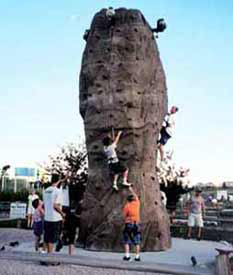 |
Mental, physical, and material preparation will be needed for this trip. The following materials will be needed: dried food, water containers, canned food, stove and starter, pots and pans, utensils, plates, cups, portable toilet, towels (paper and cloth) tent, matches, stationery items, compass, tools, maps, medicine, GPS units, weather radio, cell phones, clothing, rope, mountain climbing equipment, boots, camping materials, gun, mosquito netting, insect repellant, night vision equipment, first aide kit, toiletries, and sanitizing material. Physical preparation must include conditioning and skill development. Rock climbing, hiking, running, and doing other exercises are very important. Each team member must know enough about every part of the mission in order to be able to take the lead and make the right decisions if necessary. These include mountaineering skills, and hiking and camping skills. |
| Summary | The trip from the area of Anchorage to the base of Denali should be without incident. The path is pretty flat, and we will spend most of our time passing through low valleys between the mountains. It should take only few days to make it to base camp to prepare for the ascent of Denali. Ascent will be limited to 300 meters (1,000 feet) per day at elevations above 3000 meters (10,000 feet). We will otherwise ascend at fastest recommended rate using the West Buttress. We will climb only in the presence of ideal weather. The trip from base to summit should take about 21 days, which includes time at base camp to become used to the high altitude. We believe that ours is the best possible Extreme Travel Adventure Challenge mission plan. We have a fantastic landscape, an amazing goal, and lots of danger that we are prepared to quickly overcome. |
| References | http://7summits.com/denali/tips.php http://www.nps.gov/dena/home/mountaineering/ http://www.nps.gov/dena/ http://www.topozone.com/ http://jan.ucc.nau.edu/~cvm/latlongdist.html http://www.denali.national-park.com/ http://www.denali.national-park.com/weather.htm http://nationalatlas.gov/ |
 |
Support for program number HST-ED-90285.01-A was provided by NASA through a grant from the Space Telescope Science Institute, which is operated by the Association of Universities for Research in Astronomy, Incorporated, under NASA contract NAS5-26555. Copyright (c) 2007 Challenger Learning Center at Prairie Aviation Museum and Challenger Learning Center of Northwest Indiana. Staff of Challenger Learning Centers and instructors of classes involved with Challenger Learning Center missions may reproduce this WebQuest guide for classroom and educational purposes. Otherwise this work may not be reproduced, stored in a retrieval system, or transcribed, in any form or by means – electronic, mechanical, photocopying, recording, or otherwise – without the prior written permission of the copyright owners. This page is based upon the WebQuest model. |

